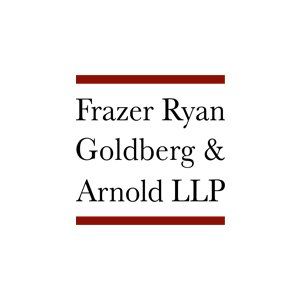Frazer Ryan Goldberg & Arnold LLP
Skilled Attorneys, Caring People, Dedicated to Our Clients' Vision for Their Future
We are a nationally recognized Phoenix boutique law firm strategically structured to satisfy the unique needs and high expectations of individuals, families, and closely held businesses.
Widely respected for our dedication to “private client” matters, our 22 skilled and innovative attorneys are organized as service-specific teams that provide peer-recognized insight, depth, and skill in the firm’s six core areas:
- Estate Planning for clients of all means, encompassing wills, trusts, tax minimization, charitable planning, and business succession
- Tax Controversy in defense of taxpayers against federal and state taxing authorities
- Trust and Estate Controversies, including contested wills and trusts, complicated probate administration, guardianships and conservatorships, alleged financial exploitation, and breaches of fiduciary duty, representing individuals, beneficiaries, personal representatives, trustees, guardians and conservators
- Business and Corporate Law encompassing entity formation and governance, buy-sell agreements, business and real estate transactions, mergers and acquisitions, ERISA and retirement planning, tax planning, and exit and succession planning
- Real Estate Law, serving businesses and property owners in meeting a broad range of transaction, property tax, and litigation needs
Central Phoenix Location
Our offices occupy the 18th floor of the Central Arts Plaza at Central Avenue and Palm Lane.
1850 N. Central Ave.
Suite 1800
Phoenix, AZ 85004
Central Phoenix Location
Our offices occupy the 18th floor of the Central Arts Plaza at Central Avenue and Palm Lane.
A Great Place to Work
-
Button
Best Places to Work: Frazer Ryan ranks #2 - and is the only law firm - in the "small companies" category (50-99 employees)
-
Birthday Sparks
ButtonFrazer Ryan: Second consecutive selection for "Arizona's Most Admired Companies"
-
Button
Frazer Ryan: "Top Companies to Work For in Arizona" 2023 = for the 9th consecutive year
Ranking Arizona 2023
Best Law Firms / Best Lawyers®
Firm News

By Jonathon Morrison
•
03 Apr, 2024
But a lesser known estate-planning tool— optimized charitable lead annuity trusts , or OCLATs—can help professional athletes, people selling their businesses, and high-net-worth individuals achieve their financial and philanthropic goals. If executed well, this strategy can deliver two to three times the initial invested sum at the end of its term. OCLATs are a version of the traditional CLAT offering, which has been a staple in the tax-planning strategies of the wealthy, including famous figures like Jacqueline Onassis, since it was introduced into the tax code in 1969. A CLAT, in its most basic form, is a charitable trust that disburses a fixed annuity or sum of money to one or more charities over a specific period of time. Once this term has come to an end, the residual assets in the trust are transferred to a noncharitable beneficiary. The OCLAT stretches the boundaries of the CLAT structure as far as IRS case law allows by making most of the charitable gifts in the latter years of the trust, thus giving investments more time to grow and more time to build family wealth. OCLATs are perfect for younger philanthropic high-earning Americans, those with large liquidity events, and those with substantial income tax obligations each year but a long time-horizon to invest. Yet despite their advantages, OCLATs are not widely used, primarily due to their perceived complexity. Indeed, many certified public accounts are unaware of their existence. This is gradually changing as more is written about this peer-reviewed income tax reduction strategy, and more professionals learn about, and recognize, its benefits. OCLATs offer a dollar-for-dollar tax deduction in the funding year (immediate tax savings of up to 30% adjusted gross income); a projected return of two to three times the original contribution (per Monte Carlo model projections accounting for the triple tax savings and assets compounding for 30 years); relief from the 40% federal gift/estate tax (because assets are removed from the taxable estate); and protection of transferred assets from bankruptcy, personal creditors, and divorce. OCLATs may not be ideal for individuals not motivated by philanthropy or those who do not have adequate personal assets outside the OCLAT. However, if the client is in a profession with a high income or has sold a highly appreciated asset and could benefit from a big state/federal tax deduction, is philanthropic, has ample savings outside the OCLAT, and would like to minimize inheritance taxes paid by children, then this is a textbook OCLAT use case. For example, if an athlete with a multiyear guaranteed contract moved $1 million of stock into an OCLAT account in 2024, he or she would save approximately $500,000 in income taxes for that year. If the stock in the OCLAT earns about 8% annually over 30 years, it leaves the athlete with $3 million for charitable donations, and some $5 million that would be transferred to the heirs tax-free (meaning no income tax or gift inheritance tax). In the event of unforeseen circumstances, like an injury that affects income, the IRS allows for the early termination of an OCLAT—with the condition of fulfilling all remaining charitable payments. Conversely, if the OCLAT investments do exceptionally well—a so-called “home run CLAT”—the vehicle can be shut down early so long as the charity gets the payment it was promised—and in any case the client still keeps the 30% income tax deduction. Interest rates could fall enough this year to bring the IRS charitable hurdle rate roughly in alignment with the 10-year Treasury yield, making the OCLAT an attractive way to maximize wealth while ensuring a lasting legacy and achieving significant tax savings.

By Frazer Ryan
•
06 Mar, 2024
FRGA Attorney Jimmy Cool was interviewed by David Abbot of the Arizona Mirror about Senate Bill 1262. This proposed legislation aims to fix problems with Arizona marijuana industry’s social equity ownership program, which called for the Arizona Department of Health Services to develop a program to promote marijuana dispensary ownership by individuals from communities harmed by the “War on Drugs.”

By Jonathon Morrison
•
03 Apr, 2024
But a lesser known estate-planning tool— optimized charitable lead annuity trusts , or OCLATs—can help professional athletes, people selling their businesses, and high-net-worth individuals achieve their financial and philanthropic goals. If executed well, this strategy can deliver two to three times the initial invested sum at the end of its term. OCLATs are a version of the traditional CLAT offering, which has been a staple in the tax-planning strategies of the wealthy, including famous figures like Jacqueline Onassis, since it was introduced into the tax code in 1969. A CLAT, in its most basic form, is a charitable trust that disburses a fixed annuity or sum of money to one or more charities over a specific period of time. Once this term has come to an end, the residual assets in the trust are transferred to a noncharitable beneficiary. The OCLAT stretches the boundaries of the CLAT structure as far as IRS case law allows by making most of the charitable gifts in the latter years of the trust, thus giving investments more time to grow and more time to build family wealth. OCLATs are perfect for younger philanthropic high-earning Americans, those with large liquidity events, and those with substantial income tax obligations each year but a long time-horizon to invest. Yet despite their advantages, OCLATs are not widely used, primarily due to their perceived complexity. Indeed, many certified public accounts are unaware of their existence. This is gradually changing as more is written about this peer-reviewed income tax reduction strategy, and more professionals learn about, and recognize, its benefits. OCLATs offer a dollar-for-dollar tax deduction in the funding year (immediate tax savings of up to 30% adjusted gross income); a projected return of two to three times the original contribution (per Monte Carlo model projections accounting for the triple tax savings and assets compounding for 30 years); relief from the 40% federal gift/estate tax (because assets are removed from the taxable estate); and protection of transferred assets from bankruptcy, personal creditors, and divorce. OCLATs may not be ideal for individuals not motivated by philanthropy or those who do not have adequate personal assets outside the OCLAT. However, if the client is in a profession with a high income or has sold a highly appreciated asset and could benefit from a big state/federal tax deduction, is philanthropic, has ample savings outside the OCLAT, and would like to minimize inheritance taxes paid by children, then this is a textbook OCLAT use case. For example, if an athlete with a multiyear guaranteed contract moved $1 million of stock into an OCLAT account in 2024, he or she would save approximately $500,000 in income taxes for that year. If the stock in the OCLAT earns about 8% annually over 30 years, it leaves the athlete with $3 million for charitable donations, and some $5 million that would be transferred to the heirs tax-free (meaning no income tax or gift inheritance tax). In the event of unforeseen circumstances, like an injury that affects income, the IRS allows for the early termination of an OCLAT—with the condition of fulfilling all remaining charitable payments. Conversely, if the OCLAT investments do exceptionally well—a so-called “home run CLAT”—the vehicle can be shut down early so long as the charity gets the payment it was promised—and in any case the client still keeps the 30% income tax deduction. Interest rates could fall enough this year to bring the IRS charitable hurdle rate roughly in alignment with the 10-year Treasury yield, making the OCLAT an attractive way to maximize wealth while ensuring a lasting legacy and achieving significant tax savings.

By Frazer Ryan
•
06 Mar, 2024
FRGA Attorney Jimmy Cool was interviewed by David Abbot of the Arizona Mirror about Senate Bill 1262. This proposed legislation aims to fix problems with Arizona marijuana industry’s social equity ownership program, which called for the Arizona Department of Health Services to develop a program to promote marijuana dispensary ownership by individuals from communities harmed by the “War on Drugs.”
Honors and Awards
5 CERTIFIED LEGAL SPECIALISTS
Scott Erickson • Brandon Keim • Jonathon Morrison • Jim Ryan • Roger Stahl
3 FELLOWS, AMERICAN COLLEGE OF TRUST & ESTATE COUNSEL
Jim Ryan • T.J. Ryan • John Fitzpatrick
7 MARTINDALE HUBBELL®
AV PREEMINENT®
RATINGS
Scott Erickson • John Fitzpatrick • Phil Rupprecht • Jim Ryan • T.J. Ryan • Phil Whitaker • Chuck Whetstine
12 BEST LAWYERS
HONOREES
Jimmy Cool • Scott Erickson • John Fitzpatrick • Doug John • Brandon Keim • Cathy Knapp • Jonathon Morrison • Lisa Reilly Payton • Phil Rupprecht • Jim Ryan • T.J. Ryan • Afsanieh Rassti
(Ones to Watch)
3 BEST LAWYERS®
PHOENIX "LAWYER OF THE YEAR" HONOREES
Jim Ryan (Trusts and Estates, 2013) • T.J. Ryan (Trust and Estate Litigation, 2015) • John Fitzpatrick (Trust and Estate Litigation, 2023)
7 SUPER LAWYERS PAST AND CURRENT HONOREES
Scott Erickson • John Fitzpatrick • Jim Ryan • T.J. Ryan • Chuck Whetstine • Jimmy Cool (Rising Stars) • Lisa Reilly Payton (Rising Stars)
© 2024
Frazer Ryan Goldberg & Arnold LLP
© 2024
All Rights Reserved | Frazer Ryan Goldberg & Arnold LLP
Privacy Policy
From our offices in central Phoenix, Frazer Ryan Goldberg & Arnold assists businesses and individuals in estate planning, tax litigation, state and local tax, business law, M&A, property tax, real estate law, tax planning, probate and trust administration, and elder law matters.
The act of visiting or communicating with Frazer Ryan Goldberg & Arnold LLP via this website or by email does not constitute an attorney-client relationship. Communications from non-clients via this website are not subject to client confidentiality or attorney-client privilege. Further, the articles, discussion, commentary, forms and sample documentation contained in this website are offered as general guidance only and are not to be relied upon as specific legal advice. For legal advice on a specific matter, please consult with an attorney who is knowledgeable and experienced in that area. Attorneys listed in this website practice only in the jurisdictions in which they are admitted. This website is governed by the Arizona Rules of Professional Conduct.
While the articles in this website accurately describe applicable law on the subject covered as of the date of publication, the law continues to develop with the passage of time. Accordingly, before relying upon this article, care should be taken to verify that the law described herein has not changed since the article's publication.










